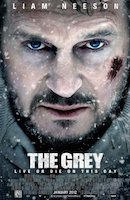
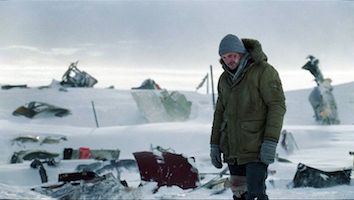

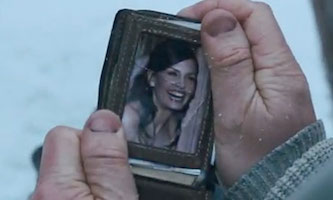

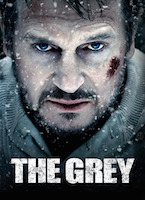
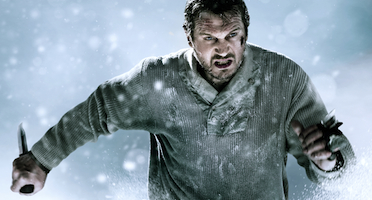
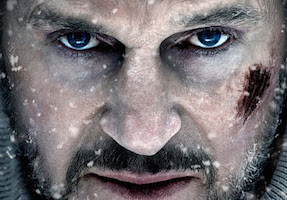
Images from "The Grey" with Liam Neeson, 2011. YouTube, Wikipedia (pdf), Amazon (pdf)
The Grey - Movie Review - Liam Neeson - A Meditation On Death, Bravery, And Dying Well
-- OR --
To Live Fully Means Being Brave And Dying Well
Cultural Criticism - May 17, 2014








Images from "The Grey" with Liam Neeson, 2011. YouTube, Wikipedia (pdf), Amazon (pdf)
2014.5.17. Saturday, 10:15 am.
Last night I watched "The Grey" with Liam Neeson. I gave it Netflix's highest rating of 5 stars. Like "The Hunter" with Willem Defoe, that I also rated at 5 stars (defined as "Really loved it!"), "The Grey" is a stark, absorbing spectacle of natural forces.
The plot revolves around a flight of roughneck oil workers that crashes in a remote area of Alaska during winter. In the coming handful of days the few who survive are picked off by wolves or perish from the elements in the most brutal fashion. It is both enlivening and sobering to see a group of tough guys facing a challenge that despite their best efforts overwhelms them. Neeson's character is one of wolf sharp shooter, someone who is paid to kill wolves that come too close to the workers as they construct pipelines and do other work for the Alaskan oil companies. Neeson is someone who understands wolves intimately. He is made expedition leader for the half-dozen survivors who leave the plane wreckage to seek shelter at a greater distance from the wolf den and in what they hope will be a more defensible location.
What did I like about it? The pace, especially. I cannot stand the fleeting attention span that most films cater to. Instead of the choppy cuts every few seconds that one finds nowadays -- and which I find disorienting to my rarified consciousness -- "The Grey" is full of long takes, close-ups, and slow pans of nature. You feel like you are there, stranded with the oil workers. The editing of the movie promotes the same sense of overwhelming isolation and vulnerability that the oil workers feel. It is clear that the human "mind" is in contact with something greater than itself. The omnipresence and invincibility of the raw forces (of both wolf and weather) can only be communicated by an unblinking record of the cruel elements at work. By unblinking I mean full minute-long scenes of nothing but snow and wind. Not that I would want to be there myself (too remote! too inhospitable!), but the natural scenery is spectacularly beautiful.
In the scene preceding the plane crash Neeson shoots a wolf intent on killing a pipeline worker. With its heart still beating, but its life slowly ebbing away, Neeson approaches it and lays his hand down on the animal's chest. For a minute the chest continues to rise and fall. Then it stops, and you can see Neeson taking stock in the significance of what took place, with his hand continuing to rest on the animal. There is nothing lightweight about this.
Gritty realism permeates the movie. Most movies today feel fake: air brushed, computer animated, voice-overed, green-roomed, illusory, characters that lie. I don't feel over-stimulated or manipulated with "The Grey." It is what it is, nothing more and nothing less. There is a powerful scene of a man dying shortly after the crash. You see blood squirting out of his abdomen with fear on his face. Liam approaches him, not like a pastor, but a man with brutal honesty and seriousness. He doesn't gloss over or deny what is happening. Neeson says, "Listen. You are going to die" and leads him verbally over the next few minutes to recollect the positive memories of his life (his daughter) and to accept the death that is creeping over him. Neeson keeps the man's eyes trained on his own. The man dies as peacefully as possible, given the situation. What more can one ask for than to be allowed to die with as much dignity and kindness as possible? When he dies, two witnesses, shakened, exclaim that they felt his spirit leave the room ("Did you feel it?" one man asks). Between this death and the death of the wolf earlier, you get the sense of "The Grey" 's profound depth and realism.
Neeson's character is one of few words. There are many long scenes of Neeson not uttering a word. It underscores the futility of language in the face of death. Stark beauty, silence, and the immediacy of life's conclusion do the talking for the film. I know people who talk too much, who talk without an emotional or even an intellectual connection to what they are saying. I don't know what this means, exactly, except that what they say rings false and is alienating to me. So it helps that Neeson speaks so little. The lack of speech also contributes to the movie's poetic quality where depth, imagery, and the audience's interior experience fill in the verbal gaps.
So these are some of the things I like about "The Grey." But what did I not like about the film?
This is not an easy question to answer. I think the actors are cast well. For the most part, their behaviors and attitudes seem believable to me.
There are some existential debates in the movie, such as whether God answers our cries for help, or does Heaven exist. Neeson, in a fit of despair, demands God to reveal Himself and extricate him from his predicament. There is no answer but the chill of winter and the howl of wolves. Maybe that is God's answer to Neeson. I think asking God to help you in a time of need is not unreasonable. As to how God reveals Him-/Her-/It-self may not be a negotiable matter. God, in my experience, simply Is, and if that includes your dying, then so be it. In any event, the movie's philosophical query is impactful enough, and does not detract from the story.
There is also an argument that people are defined by their memories. As each person dies, Neeson collects his or her wallet. At the end, with the shrieks of wolves all around him, Neeson almost worshipfully reviews the photos contained in each wallet: loved ones, wives, children, parents, special moments -- whatever memory each person cherished. Then he replaces the photos and erects a memorial built of wallets standing upright in the snow. This is the last thing he does before he dies. This also is something of a philosophical argument. What defines us? I, for one, don't reflect much on photos. But I do know that most people do. So there is resonance with this exploration of the power of images for many. What are the last things people cling to before death takes them away? Memories? Images of loved ones or special moments? Likely. "The Grey" does elevate this matter to one of direct existential consideration. But there is nothing didactic about it. In fact, the movie portrays the matter most realistically. The wallets (i.e., memories) survive long after the bodies perish. It is a true and poetic statement.
In the end, it is Neeson alone facing the wolf pack's alpha male. His journey to lead the group to safety -- and away from the wolves -- only brings him to the very den itself. The viewer sees Neeson standing in the snow -- pile of wallets nearby -- with carcasses and blood strewn about him as he braces for the impact of the enormous lunging wolf. The movie ends there. I find it unrealistic that the quest for safety would lead so directly to exactly that which you are seeking to avoid. But the scene provides a poetic climax to the film, a statement that, no matter how brave and persistent you are, some things (e.g., death) are inescapable. Fair enough. The scene serves well as a metaphor for life itself. Neeson, with no hope of surviving, does all that a man can do: face death bravely. He is there, at the end, standing with makeshift weapons in his hands, without hope, staring with unflinching determination into the oncoming wolf -- a wolf who moments earlier had silenced the pack as if to say, "This kill is mine." The movie shows no more. The viewer is left to infer what he or she will. Obviously, Neeson dies. But by omitting the obvious, we come to understand that it is not the visual details of the death that matter. What matters is a behavioral or interior quality that exists at the moment of death. What matters is how one dies. What matters is the manner in which one faces death. Philosophers say the purpose of an examined life is to die well. Clearly, Neeson dies well.
The mantra of the movie is the poem written by the Neeson's character's father, which is referenced several times, including just before Neeson's final confrontation, which goes like this:
Once more into the fray...
Into the last good fight good fight I'll ever know,
Live and die this day...
Live and die this day...
"The Grey" is a meditation on living fully, facing one's fears, being present in the moment, and dying like a "man" with dignity and not on your knees or with your eyes averted.
The "facing death" storyline of "The Grey" has spiritual significance. Every day presents an opportunity to face one's fears. If this is done faithfully, at some point it leads to an opportunity to transcend one's limited self-consciousness. The spiritual path requires Neeson's persistence and bravery. However, what is required for an emotional-spiritual flowering is more of an interior bravery. Some physical stamina and strength are helpful, but they are of secondary importance to an emotionally yielding, soft inner quality. You must be both brave and soft. Neeson does cry. He does care for others. But given his line of work and the harsh conditions he is presented with, it is difficult to believe that a spiritual flowering is possible in the circumstances. Neeson attempts to commit suicide in the first scenes of the movie. On a gut level he recognizes the bankruptcy of his life. So perhaps this could catapult him to a deeper awareness overall. But I don't think this is the thrust of the movie. "The Grey" 's focus is more upon death's immediacy and the transiency of human life.
Notes
A related quote: Permanence, perseverance and persistence in spite of all obstacles, discouragements, and impossibilities: It is this, that in all things distinguishes the strong soul from the weak. ~ Thomas Carlyle
Criminal Aerosol Spray Operations - AKA "Chemtrails"
Electrical Sensitivity, Human Health, And Environmental Illness
Electrical Sensitivity - Personal Symptoms And Reflections
Healthful Diet And Lifestyle, Environmental Toxins, And Multiple Chemical Sensitivities
Heart Chakra Opening - Signs And Symptoms
Kundalini Awakening - Spiritual Signs And Symptoms
Kundalini Awakening - Spiritual Signs And Symptoms - Additional Posts
Kundalini Awakening - Spiritual Signs And Symptoms - EMF Complications - More
Kundalini, Orgasm, Masturbation And The Spiritual Function Of Sexual Fluids
Sexual Deviancy And Its Relation To Fear, Control, Power, Vitality, Innocence, Youth, and Death
This page was first uploaded on 6-7-2014, last modified on 6-7-2014.
All contents and design by Kundalini & Cell Towers © 2014-2016